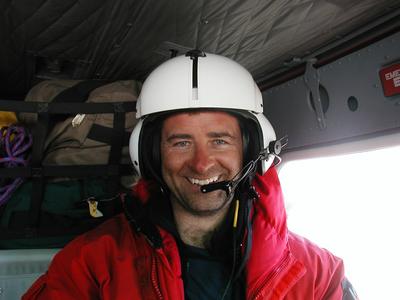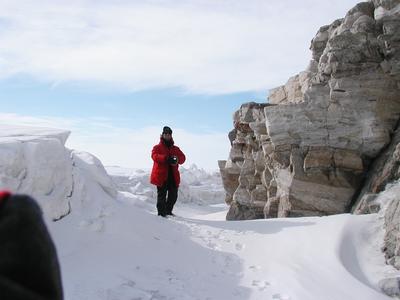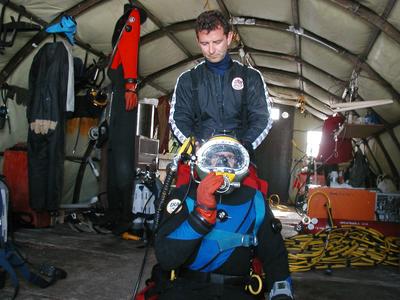18 November, 2001
Dr. Neal Pollock, The "Dive Safety Officer" on Dr. Bowser's research team,
is a research scientist with the Center for Hyperbaric Medicine and
Environmental Physiology at Duke University Medical Center. 'Environmental
Physiology' is the study of how the body responds to environmental
conditions of pressure, temperature, and other factors. 'Hyperbaric
Medicine' concerns the clinical application of pressure for the treatment
of specific diseases (for example, wounds that heal poorly and carbon
monoxide poisoning). Doctors use the hyperbaric chambers (Duke has seven
available for humans) to treat patients. The Applied Studies group that Dr.
Pollock works with is concerned with how humans respond to extreme
environments underwater, in high altitude, and in space.
Dr. Pollock has been diving for 23 years. He was born in Edmonton, Alberta
where he began his study of marine biology. His background in marine
science led him to pursue a masters in exercise physiology (with a focus on
diving physiology) and a doctorate in exercise and environmental
physiology. Dr. Pollock's scientific diving history and cold water diving
experience was instrumental in bringing him to the extreme conditions of
diving in the cold Antarctic waters. He began diving in Antarctica in 1990,
then continued in 1993, 1994, 1999, and 2001.
Dr. Pollock's work at Duke University involves studying the effects of
high and low pressure on the bodies of people working in extreme
environments, whether they are diving underwater or working in space. The
Applied Studies group conducts research to optimize decompression
procedures for those with special needs - divers, high altitude
parachutists, and astronauts. The following describes pressure effects. As
a diver descends (goes down) in the ocean, the pressure surrounding the
body increases and additional gas from the lung flows into the body. When
the diver returns to the surface, the ascent must be made slowly enough to
allow the excess gas in the body to be removed from the lung safely.
According to Dr. Pollock, if a diver ascends too quickly, the nitrogen gas
can make the blood and tissues "fizz like a coke bottle opened after being
shaken" (other gases may be involved, but nitrogen is the typical culprit).
This is known as decompression sickness or the 'bends.' One variation of
these studies has Dr. Pollock and his colleagues determining how long
divers should wait between diving and flying in order to avoid
decompression sickness (since flying reduces the pressure surrounding the
body and increases the decompression stress of the dive).
Another variation of their studies is funded by NASA. Astronauts must
decompress to work outside in spacesuits (extravehicular activity - EVA -
or spacewalking). The spacesuits hold a reduced pressure to allow the
astronaut to move more easily. The project goal is to help astronauts
decompress safely and as fast as possible. Efficiency is becoming more
important now with the numerous spacewalks required for the construction
and maintenance of the new International Space Station. The group that Dr.
Pollock works with is trying to find the best combination of
oxygen-breathing and exercise to remove nitrogen from the body prior to
decompression and thereby reduce the risk of decompression sickness.
Exercise increases both blood flow and breathing. When exercise is combined
with oxygen breathing, nitrogen rapidly leaves the body.
Dr. Pollock's diving and research in Antarctica gives him the opportunity
to experience extreme conditions firsthand in order to guide his research.
He is also collecting data in Antarctica for Project Dive Exploration
(PDE), a study developed by the Divers Alert Network (DAN). The long term
objective of the project is to collect computerized records from one
million actual scuba dives. Volunteer divers wear small computers that
monitor their activity. An accurate record of the profile of each dive is
measured. Ultimately, this data will provide an indication of the true risk
of decompression sickness and help to identify factors that may affect
individual risk.

Neal heading back to McMurdo by helicopter.

Dr. Neal Pollock at Marble Point.

Dr. Pollock helping get Phil Forte ready for a surface air supply dive.
Contact the TEA in the field at
.
If you cannot connect through your browser, copy the
TEA's e-mail address in the "To:" line of
your favorite e-mail package.
|
